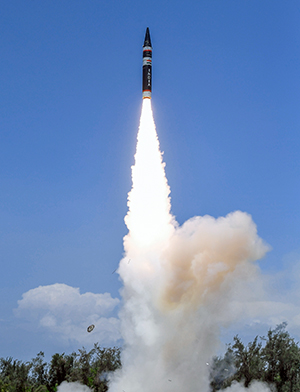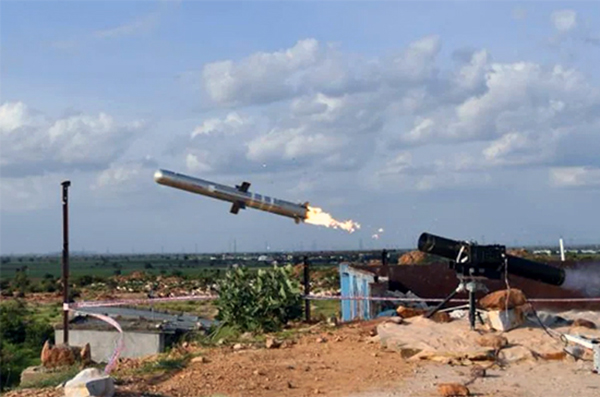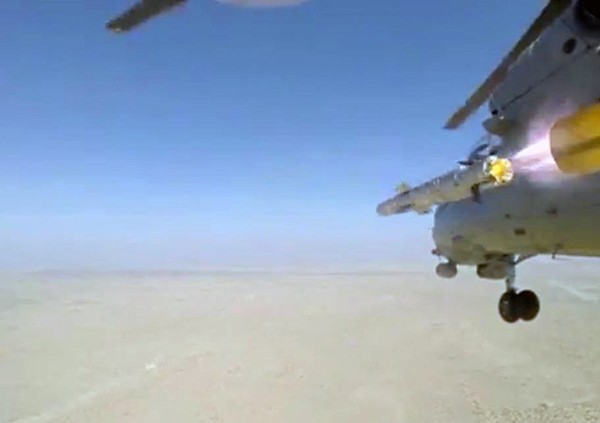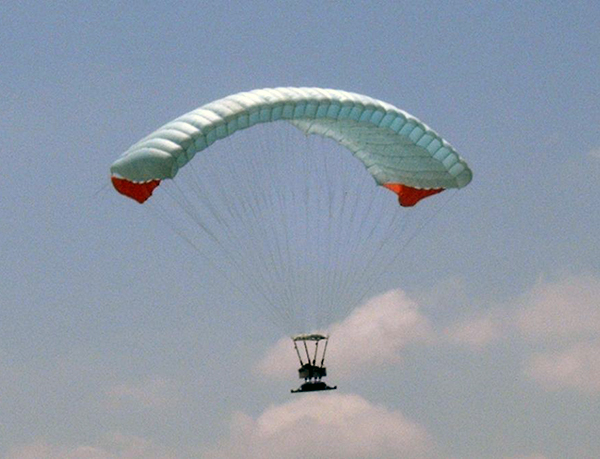‘Agni P’ New-gen Ballistic Missile Tested
India, on 18 December, successfully India successfully tested nuclear-capable ballistic missile ‘Agni P’, a two-stage canisterised solid propellant ballistic missile with dual redundant navigation and guidance system.
The test was carried out from Dr APJ Abdul Kalam Island off the Odisha coast. “Various telemetry, radar, electro-optical stations and downrange ships positioned along the eastern coast tracked and monitored the missile trajectory and parameters. The missile followed textbook trajectory, meeting all mission objectives with a high level of accuracy,” the Defence Research and Development Organisation (DRDO) said in a statement.
This second flight-test has proven the reliable performance of all the advanced technologies integrated into the system, it said.
The surface-to-surface ballistic missile has a range of 1,000 to 2,000 km.
DRDO Tests Man Portable Anti-Tank Guided Missile
The DRDO, on 11 January, successfully flight tested the final deliverable configuration of the Man Portable Anti-Tank Guided Missile (MPATGM). The indigenously developed anti-tank missile is a low weight, ‘fire and forget’ missile and is launched from a man portable launcher, integrated with thermal sight.
During the test, which was conducted at a range in Southern India, the missile impacted the designated target with precision and destroyed it. The final impact event was captured on camera. The purpose of this particular test was to prove the consistent performance for the missile system at its minimum range.
Because of the strategic importance of tanks and armoured vehicles in modern day battlefields since World War I, the development of ammunition that can beat the armour of tanks and the development of armour that would withstand anti-armour ammo has been an ongoing race since then.
While the Indian Army has been mainly using various imported anti-tank guided missiles in the past, the DRDO has been working on ATGMs to be launched from different platforms as part of the Integrated Guided Missile Development Programme.
The indigenously developed MPATGM, ATGM Nag and Helicopter launched ATGM Nag or Helina have been successfully tested in the recent past under various conditions. In a related development, the Indian government, in December 2019, procured Anti Tank Spike missiles from Israel along with the allied systems to meet operational requirements of the Indian Army.
Helicopter-launched stand-off anti-tank missile Tested
India, on 11 December, successfully flight-tested indigenously developed helicopter-launched stand-off anti-tank (SANT) missile in Rajasthan’s Pokhran firing ranges. The weapon, developed for the IAF, can neutralise targets in a range up to 10 km.
The defence ministry said the flight-testing, carried out by the DRDO and the Indian Air Force, was “successful” in meeting all the mission objectives of the missile.
“The flight-test was successful in meeting all its mission objectives. The release mechanism, advanced guidance and tracking algorithms, all avionics with integrated software, performed satisfactorily and tracking systems monitored all mission events,” it said.
The ministry said the missile is equipped with a state-of-the-art MMW seeker which provides high precision strike capability from a safe distance.
The SANT missile has been designed and developed by Research Centre Imarat (RCI), Hyderabad. in coordination with other DRDO labs and participation from industries.
“This is the third in the series of indigenous stand-off weapons to be tested in recent times after long-range bomb and smart anti airfield weapon for strengthening the arsenal of IAF,” the ministry said in a statement.
Indigenous Brahmos Supersonic Cruise Missile Tested
India, on 11 January, successfully test-fired the indigenously designed and manufactured Brahmos supersonic cruise missile. It was a validation test of the naval variant of the missile jointly manufactured by Russia and India. The missile was fired from a stealth guided-missile destroyer. The DRDO said the missile hit the designated target “precisely”.
BrahMos Aerospace, the first India-Russian joint venture, produces the supersonic cruise missile that can be launched from submarines, ships, aircraft, or land platforms.
BrahMos missile flies at a speed of 2.8 Mach or almost three times the speed of sound. The Army and Navy have already inducted the highly versatile missile.
Given the effectiveness of the missile capable of hitting targets at a range of more than 350 kms, operational commanders have deployed the Brahmos at various critical points along the Line of Actual Control (LAC) facing China.
Flight demonstration of Controlled Aerial Delivery System
The DRDO has conducted a flight demonstration of its controlled aerial delivery system having the capability to deliver 500 kilograms of payload. The demonstration was carried out by the DRDO’s Aerial Delivery Research and Development Establishment (ADRDE) in Agra on 18 December.
The Controlled Aerial Delivery System of 500-kilogram capacity (CADS-500) is used for precise delivery of payloads up to 500 kilograms at a predetermined location by making use of manoeuvrable capabilities of Ram Air Parachute (RAP).
The CADS, with its onboard electronics unit, autonomously steers its flight path using waypoint navigation towards target location by operating controls, it said in a statement.
Survival Kit For Troops in Extreme Cold Areas
The DRDO, on December 27, handed over technology for making extreme cold weather clothing to five Indian companies. The Extreme Cold Weather Clothing System (ECWCS) is meant for troops operating at the limits of human endurance in high altitude areas and provides thermal protection against temperatures as low as Minus 50 degrees Celsius.
The DRDO designed ECWCS is an ergonomically designed modular technical clothing with improved thermal insulation and physiological comfort based on the insulation required at various ambient climatic conditions in Himalayan regions during different levels of physical activity.
“The ECWCS embodies physiological concepts related to reduction in respiratory heat and water loss, unhindered range of motions and rapid absorption of sweat while providing water proof, wind proof features with adequate breathability and enhanced insulation as well as strength features required for high altitude operations,” a Ministry of Defence statement said.
“The three layered ECWCS is designed to suitably provide thermal insulation over a temperature range of +15 to -50° Celsius with different combinations of the layers and intensity of physical work,” it elaborated. The layered clothing reduces the requirement for different combinations to provide for widely fluctuating weather conditions on the Himalayan peaks.
Electronics and Communication Systems Transferred to Industry
Secretary DD R&D and Chairman DRDO Dr G Satheesh Reddy, handed over three products developed by MED & CoS Cluster of DRDO to user laboratories on 16 December. He also handed over four Transfer of Technology (ToT) agreements to public and private sector companies.
The GaN process development kit has been released for MMIC designers to enable them to design indigenous GaN MMICs for various frequencies upto X-band. The devices can be manufactured at GAETEC.
Secretary DD R&D handed over High-g MEMS Switch, UHF 1kW High Power Amplifier and X band Power Amplifier to user laboratories. He also handed over SSPL developed technology of 0.5W Stirling Cryo-cooler for Integrated Detector Dewar Cooler Assembly (IDDCA) to Bharat Electronics Limited.
Technology document of 10W laser diode chip fabrication technology and X-band GaN HEMT MMIC was handed over to GAETEC. Technology document for HgCdTe based DDCA was handed over to STAR-C.
The technology of Acoustic Emission (AE) Sensors, AE Data Acquisition & Analysis System was handed over to industry. The sensors and the system will be used for site specific snow avalanche monitoring/prediction.
Building upon the existing security matrix, Secretary, DD R&D handed over CAIR developed INDIGIS, a Geographical Information System to industry. Secure mobile handset to facilitate secure transmission of voice and instant messaging over 4G cellular networks for usage in sensitive environment was launched.
Reliable and secure key transfer Quantum Key Distribution (QKD) at a distance over 100 km using commercial telecom optical fiber link was announced.






















